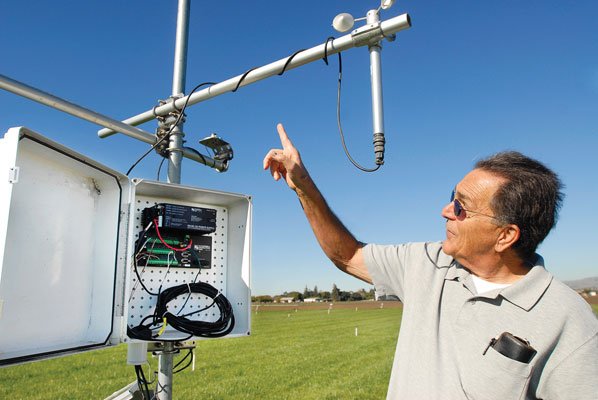As farmers face drought conditions and tightened restrictions,
growers are trying to be as water-efficient as possible.
As farmers face drought conditions and tightened restrictions, growers are trying to be as water-efficient as possible. A new weather station in Gilroy allows them to do just that, monitoring information on solar radiation, wind direction and speed, humidity, and air and soil temperature that local growers can access online.
Syngenta, a Switzerland-based seed company, paid about $5,000 for the basic weather station before attaching additional devices to it. The station stands at Syngenta’s Holsclaw Road site about two miles south of Leavesley Road. The Santa Clara Valley Water District maintains the weather station, which provides data to the state Department of Water Resources’ California Irrigation Management Information System that is posted online.
“It is a useful tool for the community,” said Joe Benson, site manager for Syngenta.
The station began operating in October. Benson said the information that the device provides has proven helpful.
The CIMIS station provides information that allows growers to make irrigation decisions daily rather than getting information from irrigation trials after the growing season is complete, said Bob Siegfried, an agricultural engineer for the Santa Clara Valley Water District.
The station is powered via a solar panel, and it includes a spinning windmill-like contraption that can measure windspeed and direction among other devices. Perhaps most importantly, it can measure the loss of irrigation water to the atmosphere through evaporation and transpiration.
Syngenta placed the station on grass. Water use information for that commodity can easily be translated into water figures for other crops because so many comparative studies have been done with grass, Siegfried said.
“People have worked with grass and water use for decades and decades,” Siegfried explained.
Syngenta, which focuses on seed development and crop protection, is using the information it collects for its irrigation practices and for drought research. Benson noted that the company is trying to create seeds that can grow in drought conditions. Similarly, the station can help local growers and the urban/landscaping industry, such as golf course managers and landscapers, plan for efficient irrigation. It also can help local farmers understand optimal strategies for growing crops when faced with water restrictions.
“This is consistent with our focus on sustainable agriculture, which is at the heart of everything we do,” Benson said.
Syngenta’s station is the first in Gilroy, though there are more than 130 such stations in the state. The CIMIS station data is reliable up to 10 miles away from the station, Benson said.
The water district initially expressed interest in setting up a weather station in San Martin on its own about a year ago after a CIMIS station at Live Oak High School in Morgan Hill closed down in May 2008.
However, the district’s board voted down the idea in November 2008 because members thought it was too expensive to build a new well on the San Martin site. Siegfried said the agreement between water district, Syngenta and the Department of Water Resources benefits all parties involved.
He noted that cherry growers particularly have taken advantage of CIMIS data in the past, as they use information to determine spray times.
Many of them contacted Siegfried when the Live Oak station was closed, as it had been running since 1997, he said.
“When we closed down the station at Morgan Hill, my phone started ringing off the hook,” Siegfried recalled.
Ralph Santos, owner of El Camino Orchards, noted that cold weather conditions cause dormancy within a cherry bloom, and farmers do not want to spray trees before that chilling takes place. The Lodi-based California Cherry Advisory Board extracts information from the Gilroy station and shares it with cherry growers. On the other hand, the University of California cooperative extension, which takes CIMIS figures and translates them into useful data for various fruit and nut growers, does not yet have any information from the Gilroy station online.
Morgan Hill cherry grower Andy Mariani said the former Morgan Hill CIMIS station was particularly useful because it was right across the street from his property. Temperatures in Gilroy are slightly cooler in Gilroy than in Morgan Hill, he said, so data from the new station is not quite as accurate for his orchards. Still, it is better to have the Gilroy station than to not have one in the area at all, Mariani said.
Both active and inactive station data are available on the CIMIS Web site at www.cimis.water.ca.gov/cimis/welcome.jsp. Santa Clara Valley Water District’s Web site contains information that can help farmers and landscapers calculate irrigation timing and amount based on CIMIS data. For information: www.valleywater.org














